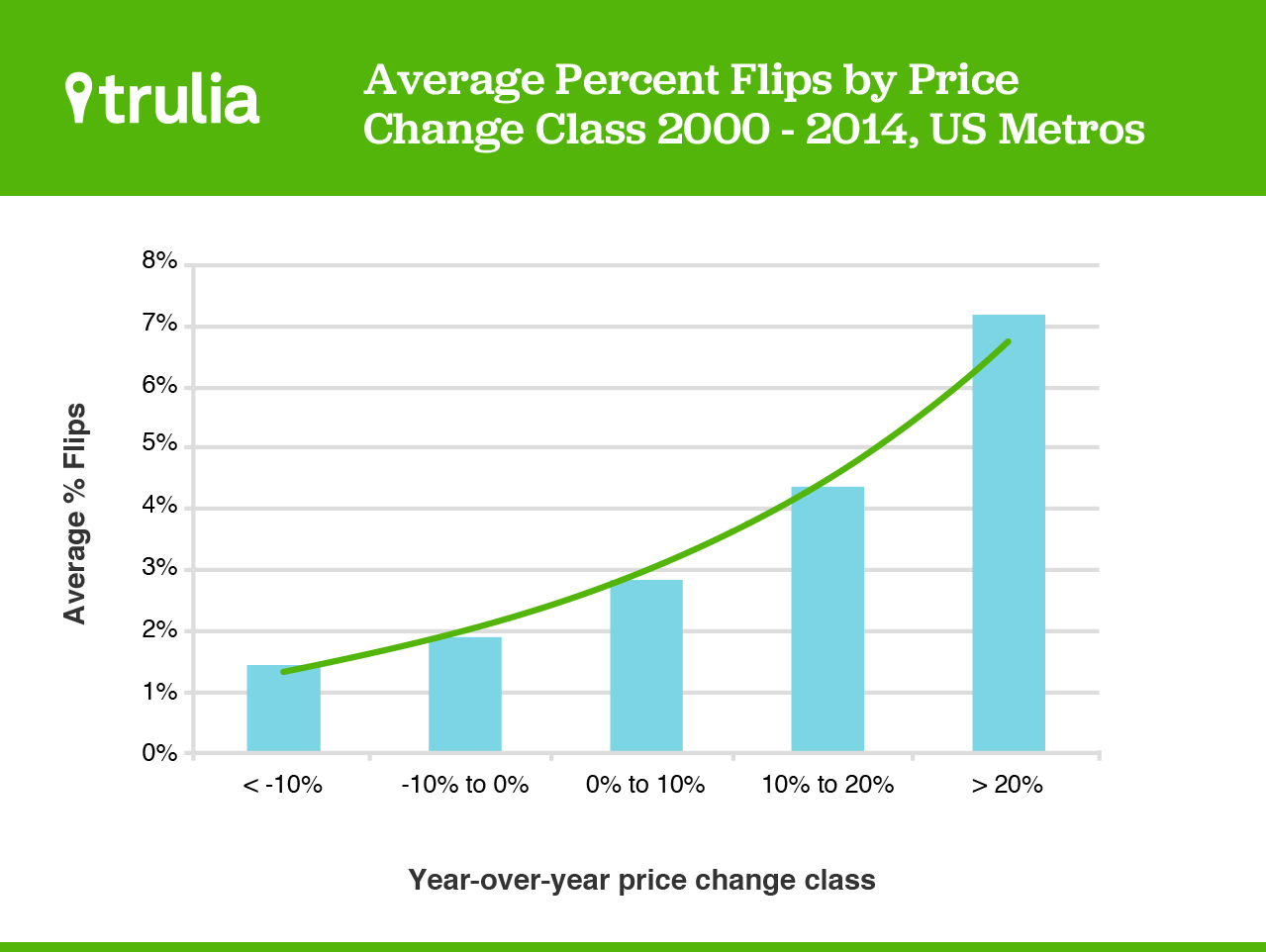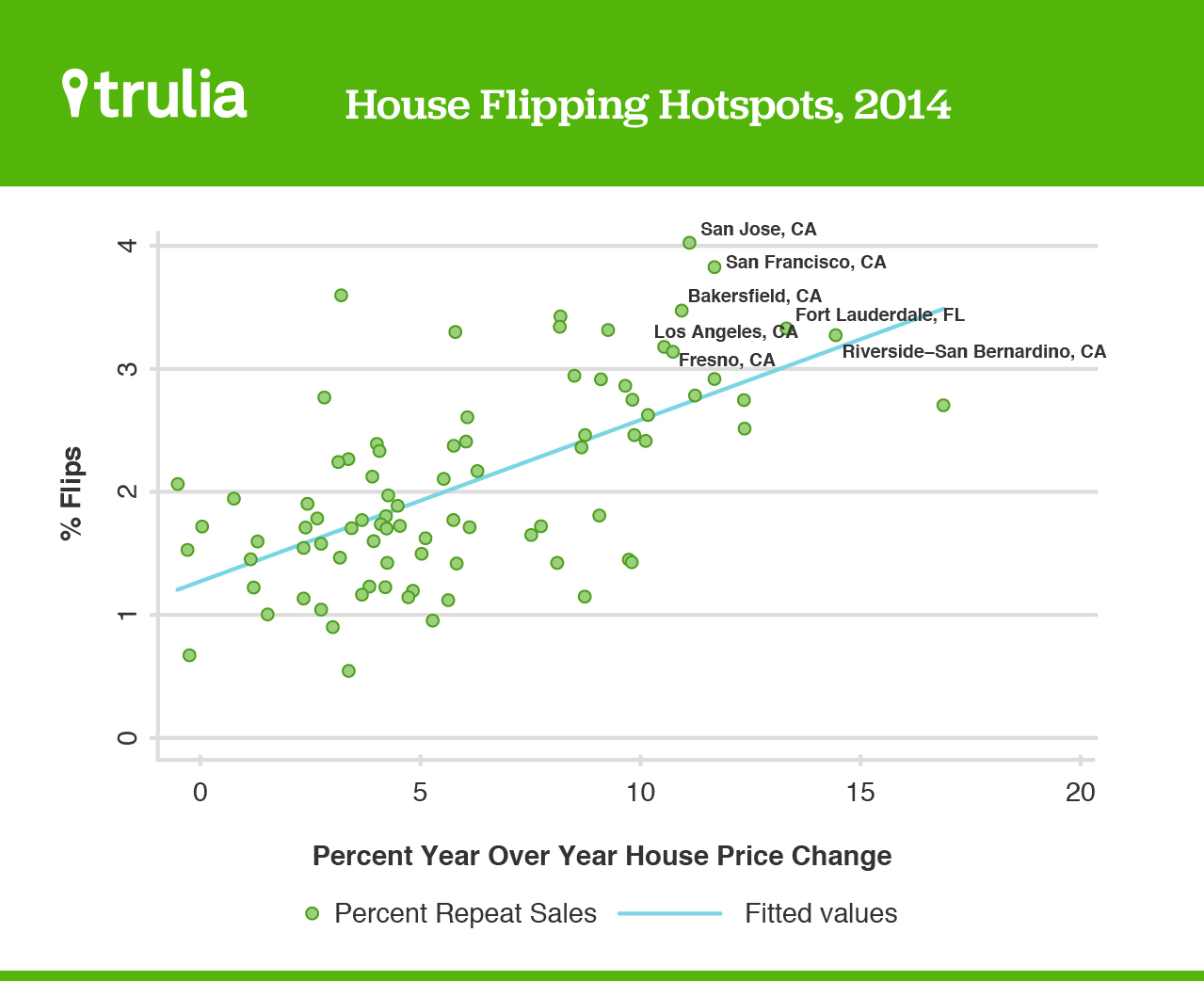Flipping is the practice of buying a house and reselling in a short period. Both professional and casual investors flip houses. And like other asset trading, successful flipping involves buying at a discount, selling at a premium, or both—all of which is sensitive to changes in housing prices. We at Trulia Trends set out to explore at what point in the housing market price cycle flipping activity pick ups.
Selling houses at a premium generally requires price growth. The more prices are rising, the more profitable it is to flip. Thus, when prices are rising faster, flippers have greater opportunity to come out ahead. However, flipping activity can also accelerate when prices fall. That’s because foreclosures provide investors opportunities to get properties at discounted prices. To tease out how price increases affect flipping activity, we focus exclusively on nondistressed sales—transactions not involving foreclosures or short sales—of homes that had last sold within the previous 12 months.

A chart of home-price-change and flip percentages nationwide from the first quarter of 2000 to the third quarter of 2014 shows flipping sped up as prices rose and slowed as prices fell. In the first quarter of 2000, flippers turned over about 4% of all U.S arm’s length transactions, that is, transactions in which the buyer and seller are independent parties. By the third quarter of 2005, the percentage of flips had increased to nearly 7% of all arm’s length transactions. Between these two quarters, year-over-year increases in the FHFA national house price index went from just over 6% to almost 11%. Then, as prices plunged during the housing crash, the percentage of flips fell in 2011 to a low of 2% of all arm’s length transactions.
To better understand flipping, we grouped average flips at the metro level between 2000 and 2014 by level of year-over-year price changes. We found the flipping point—the point at which flipping activity picks up—to be around 10% year-over-year price growth. Metros that experienced year-over-year price declines had flipping rates between 1% and 2%. By contrast, metros that had 10% or more price growth on average had flipping activity between 4% and 7%.

But this is old news. What has happened with flipping lately? To get a current look, we plotted price changes and flip percentages for the 100 largest metros over the past year. We found a strong positive relationship. Metros with the highest flipping activity generally had above-average home price gains.

Six of the top 10 metros for flipping from the third quarter of 2013 to the third quarter of 2014 were in California. Nashville, Knoxville, Fort Lauderdale, and Cambridge-Newton-Framingham rounded out the list. Nearly all our top-ten flipper metros experienced above-median price gains in 2014 and most posted price growth near or above double digits. Still, we aren’t anywhere near the levels of frenzied flipping seen during the housing bubble, despite similar year-over-year price gains in many metros. All of the metros that registered year-over-year price growth above the critical 10% point had flipping activity around 3% to 4%. That’s on par with average flipping at that price growth range between 2000 and 2014—in other words, flipping is occurring at a historically normal rate. Moreover, we’re predicting slowing price growth in 2015 and flipping should moderate. You might say, we’re not expecting the housing market to flip out anytime soon!
| Top 10 Metros With the Most Arms-Length Flips, 2013-2014 | |||
| # | U.S. Metro | % Flips, 2013Q3 – 2014Q3 | % YOY Price Change, 2013Q3 – 2014Q3 |
| 1 | San Jose, CA | 4.0% | 11.1% |
| 2 | San Francisco, CA | 3.8% | 11.7% |
| 3 | Knoxville, TN | 3.6% | 3.2% |
| 4 | Bakersfield, CA | 3.5% | 10.9% |
| 5 | Nashville, TN | 3.4% | 8.2% |
| 6 | Orange County, CA | 3.3% | 8.2% |
| 7 | Fort Lauderdale, FL | 3.3% | 13.3% |
| 8 | Ventura County, CA | 3.3% | 9.3% |
| 9 | Cambridge-Newton-Framingham, MA | 3.3% | 5.8% |
| 10 | Riverside-San Bernardino, CA | 3.3% | 14.4% |
| Note: Median year-over-year price growth is 5.11%. Year-over-year price changes are calculated using the FHFA quarterly house price index. | |||
Note on methodology:
We differentiate between two different types of property flips: a “traditional flip,” which is the purchase of a house at market rate and selling it at a higher market rate price, because of improvement to the property and/or rising prices; and a “clearance flip,” which is the purchase of a distressed house at a discount because of a forced sale, such as a foreclosure, followed by a resale at market rate. We do not include clearance flips in our measure of flipping since our goal is to estimate the relationship between prices and flipping in a relatively normal, non-distressed housing market. As a result, our definition of a flip is a property that sold twice in a twelve-month period, in which both transactions are considered arm’s length.

